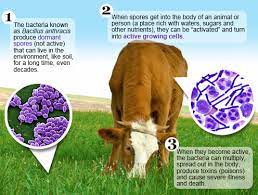Anthrax is a serious infectious disease caused by gram-positive, rod-shaped bacteria known as Bacillus anthracis. It occurs naturally in soil and commonly affects domestic and wild animals around the world. People can get sick with anthrax if they come in contact with infected animals or contaminated animal products. Anthrax can cause severe illness in both humans and animals.
Anthrax is not contagious, which means you can’t catch it from another person like the cold or flu.
How people get infected with anthrax
People get infected with anthrax when spores get into the body. When anthrax spores get inside the body, they can be “activated.” The bacteria can then multiply, spread out in the body, produce toxins, and cause severe illness.
This can happen when people breathe in spores, eat food or drink water contaminated with spores, or get spores in a cut or scrape in the skin. It is very uncommon for people in the United States to get infected with anthrax.
How animals get infected with anthrax
Domestic and wild animals can become infected when they breathe in or ingest spores in contaminated soil, plants, or water. These animals can include cattle, sheep, goats, antelope, and deer. In areas where domestic animals have had anthrax in the past, routine vaccination can help prevent outbreaks.
Where anthrax is found
Anthrax is most common in agricultural regions of
- Central and South America,
- sub-Saharan Africa,
- central and southwestern Asia,
- southern and eastern Europe, and
- the Caribbean.
Anthrax is rare in the United States. However, sporadic outbreaks do occur in wild and domestic grazing animals such as cattle or deer. Anthrax is more common in countries that do not have programs that routinely vaccinate animals against anthrax. In the United States, veterinarians recommend yearly vaccination of livestock in areas where animals have had anthrax in the past.
Certain activities can increase the chances of getting anthrax
Working with infected animals or animal products
Most people who get sick from anthrax are exposed while working with infected animals or animal products such as wool, hides, or hair.
Inhalation anthrax can occur when a person inhales spores that are in the air (aerosolized) during the industrial processing of contaminated materials, such as wool, hides, or hair.
Cutaneous anthrax can occur when workers who handle contaminated animal products get spores in a cut or scrape on their skin.
Eating raw or undercooked meat from infected animals
People who eat raw or undercooked meat from infected animals may get sick with gastrointestinal anthrax. This usually occurs in countries where livestock are not routinely vaccinated against anthrax and food animals are not inspected prior to slaughter.
In the United States, gastrointestinal anthrax has rarely been reported. This is because yearly vaccination of livestock is recommended in areas of the United States where animals have had anthrax in the past, and because of the examination of all food animals, which ensures that they are healthy at the time of slaughter.



